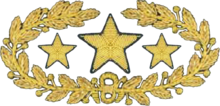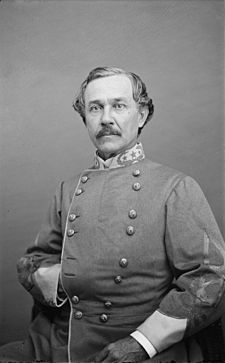- General officers in the Confederate States Army
-
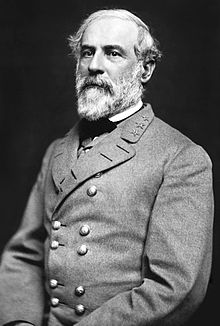 Robert E. Lee, the most well-known CSA general. Lee is shown with the insignia of a Confederate colonel, which he chose to wear throughout the war.
Robert E. Lee, the most well-known CSA general. Lee is shown with the insignia of a Confederate colonel, which he chose to wear throughout the war.
The general officers of the Confederate States Army (CSA) - the army of the Confederate States of America - were the senior military leaders of the Confederacy and served during the American Civil War between 1861 and 1865. They were often former officers from the United States Army (the regular army) prior to the Civil War, while others were given the rank based on merit or when necessity demanded. Most Confederate generals needed confirmation from the Confederate Congress, much like prospective generals in the modern U.S. armed forces.
Like all of the Confederacy's military forces, these generals answered to their civilian leadership, in particular Jefferson Davis, the South's president and therefore "commander-in-chief" of the Army, Navy, and Marines in the Confederate States.
Contents
History
Much of the design of the Confederate States Army was based on the structure and customs of the U.S. Army[1] when the Confederate Congress established their War Department on February 21, 1861.[2] The Confederate Army was composed of three parts; the Army of the Confederate States of America (ACSA, intended to be the permanent, regular army), the Provisional Army of the Confederate States (PACS, or "volunteer" Army, to be disbanded after hostilities), and the various Southern state militias.
Graduates from West Point and Mexican War veterans were highly sought after by Jefferson Davis for military service, especially as general officers. Like their Federal counterparts, the Confederate Army had both professional and political generals within it. Ranks throughout the CSA were roughly based on the U.S. Army in design and seniority.[3] On February 27, 1861, a general staff for the army was authorized, consisting of four positions: an adjutant general, a quartermaster general, a commissary general, and a surgeon general. Initially the last of these was to be a staff officer only.[2] The post of adjutant general was filled by Samuel Cooper (the position he had held as a colonel in the U.S. Army from 1852 until resigning) and he held it throughout the Civil War, as well as the army's inspector general.[4]
Initially the Confederate Army commissioned only brigadier generals in both the volunteer and regular services;[2] however, the Confederate Congress quickly passed legislation allowing for the appointment of major generals as well as generals, thus providing clear and distinct seniority over the existing major generals in the various state militias.[5] On May 16, 1861, when there were only five officers at the grade of brigadier general, this legislation was passed, which stated in part:
That the five general officers provided by existing laws for the Confederate States shall have the rank and denomination of 'general', instead of 'brigadier-general', which shall be the highest military grade known to the Confederate States...[6]As of September 18, 1862, when lieutenant generals were authorized, the Confederate Army had four grades of general officers; they were (in order of increasing rank) brigadier general, major general, lieutenant general, and general.[7] As officers were appointed to the various grades of general by Jefferson Davis (and were confirmed), he would create the promotion lists himself. The dates of rank, as well as seniority of officers appointed to the same grade on the same day, were determined by Davis "usually following the guidelines established for the prewar U.S. Army."[8]
Brigadier general
These generals were most often infantry or artillery brigade commanders, aides to other higher ranking generals, and War Department staff officers. By war's end the Confederacy had at least 383 different men who held this rank in the PACS, and three in the ACSA: Samuel Cooper, Robert E. Lee, and Joseph E. Johnston.[9] The organization of regiments into brigades was authorized by the Congress on March 6, 1861. Brigadier generals would command them, and these generals were to be nominated by Davis and confirmed by the Confederate Senate.[2]
Though close to the Union Army in assignments, Confederate brigadiers mainly commanded brigades while Federal brigadiers sometimes led divisions as well as brigades, particularly in the first year of the war. These generals also often led sub-districts within military departments, with command over soldiers in their sub-district. These generals outranked Confederate Army colonels, who commonly led infantry regiments.
This rank is equivalent to brigadier general in the modern U.S. Army.
Major general
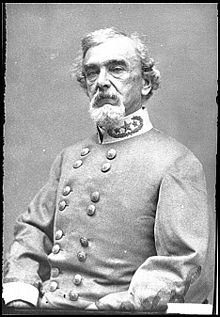 Maj. Gen. Benjamin Huger, CSA
Maj. Gen. Benjamin Huger, CSA
These generals were most commonly infantry division commanders, aides to other higher ranking generals, and War Department staff officers. They also led the districts that made up military departments, and had command over the troops in their districts. By war's end the Confederacy had at least 88 different men who had held this rank, all in the PACS.[10]
Divisions were authorized by the Congress on March 6, 1861, and major generals would command them. These generals were to be nominated by Davis and confirmed by the Senate.[2] Major generals outranked brigadiers and all other lesser officers.
This rank was not synonymous with the Union's use of it, as Northern major generals led divisions, corps, and entire armies. This rank is equivalent in most respects to major general in the modern U.S. Army.
Major general line command list
Not further promoted; top 20
- Abbreviations: NC = non-combat death, MW = mortally wounded
Name Date of Rank[8] Rank Terminated[8] Reason David E. Twiggs May 22, 1861 October 11, 1861 retired Earl Van Dorn September 19, 1861 May 8, 1863 murdered/TN, Spring Hill Gustavus W. Smith September 19, 1861 February 17, 1863 resigned Benjamin Huger October 7, 1861 June 12, 1865 paroled John B. Magruder October 7, 1861 no record no record Mansfield Lovell October 7, 1861 temporary unknown temporary unknown George B. Crittenden November 9, 1861 October 23, 1862 resigned William W. Loring February 15, 1862 May 1, 1865 paroled Sterling Price March 6, 1862 no record no record Benjamin F. Cheatham March 10, 1862 May 1, 1865 paroled D. R. Jones March 10, 1862 January 15, 1863 died John P. McCown March 10, 1862 May 12, 1865 paroled S. Jones March 19, 1862 May 12, 1865 paroled D.H. Hill March 26, 1862 May 1, 1865 paroled Jones M. Withers April 6, 1862 May 11, 1865 paroled Thomas C. Hindman April 14, 1862 no record no record John C. Breckinridge April 14, 1862 no record no record Lafayette McLaws May 23, 1862 no record no record J.E.B. Stuart July 25, 1862 May 12, 1864 MW, Yellow Tavern Samuel G. French August 31, 1862 no record no record George E. Pickett October 10, 1862 April 9, 1865 paroled Carter L. Stevenson October 10, 1862 May 1, 1865 paroled[11] Lieutenant general
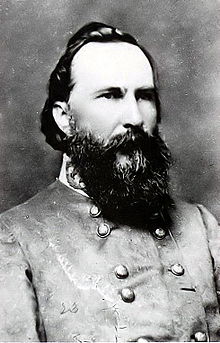 Lt. Gen. James Longstreet, CSA
Lt. Gen. James Longstreet, CSA
There were 18 lieutenant generals in the Confederate Army, and these general officers were often corps commanders within armies or military department heads, in charge of geographic sections and all soldiers in those boundaries. All of the Confederacy's lieutenant generals were in the PACS.[10] The Congress legalized the creation of army corps on September 18, 1862, and directed that lieutenant generals lead them. These generals were to be nominated by Davis and confirmed by the Senate.[7] Lieutenant generals outranked major generals and all other lesser officers.
This rank was not synonymous with the Federal use of it; Ulysses S. Grant was one of only two Federal lieutenant generals during the war, the other being Winfield Scott who received a promotion to Brevet Lieutenant General by a special act of Congress in 1855. Grant was by the time of his promotion, March 9, 1864, the only Federal Lieutenant General in active service. Grant became Commander of all the Unions armies, answering only to Abraham Lincoln and was charged with the task of leading the Union armies to victory over the Confederacy. The CSA Lieutenant General rank is roughly equivalent to lieutenant general in the modern U.S. Army.
The Confederate Congress passed legislation in May 1864 to allow for "temporary" general officers in the PACS, to be appointed by Jefferson Davis and confirmed by the Senate, and given a non-permanent command by Davis.[12] Under this law Davis appointed several officers to fill open positions. Richard H. Anderson was appointed a "temporary" lieutenant general on May 31, 1864, and given command of the First Corps (following the wounding of Lt. Gen. James Longstreet on May 6 in the Wilderness.) With Longstreet's return that October, Anderson reverted to a major general. Jubal Early was appointed a "temporary" lieutenant general on May 31, 1864, and given command of the Second Corps (following the re-assignment of Lt. Gen. Richard S. Ewell to other duties) and led it until December 1864, when he too reverted to a major general. Likewise both Stephen D. Lee and Alexander P. Stewart were appointed fill to vacancies in the Western Theater as "temporary" lieutenant generals, and also reverted to their prior grades as major generals as those assignments ended. However, Lee was nominated a second time for lieutenant general on March 11, 1865, and was confirmed as such five days later.[13]
Lieutenant general line command list
- Abbreviations: KIA = killed in action, MW = mortally wounded
Lieutenant general line command list Name Date of Rank[8] Nominated[13] Confirmed[13] Rank Terminated[8] Reason[8] James Longstreet October 9, 1862 October 10, 1862 October 11, 1862 April 9, 1865 paroled Edmund Kirby Smith October 9, 1862 October 10, 1862 October 11, 1862 February 19, 1864 promoted to general Leonidas Polk October 10, 1862 October 10, 1862 October 11, 1862 June 14, 1864 KIA, Pine Mountain Theophilus H. Holmes October 10, 1862 October 10, 1862 October 13, 1862 no record no record William J. Hardee October 10, 1862 October 10, 1862 October 11, 1862 May 1, 1865 paroled Stonewall Jackson October 10, 1862 October 10, 1862 October 11, 1862 May 10, 1863 MW, Chancellorsville John C. Pemberton October 10, 1862 October 10, 1862 October 13, 1862 May 18, 1864 resigned Richard S. Ewell May 23, 1863 May 23, 1863 February 2, 1864 July 19, 1865 paroled A.P. Hill May 24, 1863 May 23, 1863 January 15, 1864 April 2, 1865 KIA, Petersburg John Bell Hood September 20, 1863 February 1, 1864 February 4, 1864 May 31, 1865 paroled Richard Taylor April 8, 1864 May 14, 1864 May 16, 1864 May 11, 1865 paroled Jubal Early May 31, 1864 May 31, 1864 May 31, 1864 no record no record Richard H. Anderson May 31, 1864 May 31, 1864 May 31, 1864 no record no record Alexander P. Stewart June 23, 1864 June 23, 1864 February 20, 1865 May 1, 1865 paroled Stephen D. Lee June 23, 1864 March 11, 1865 March 16, 1865 May 1, 1865 paroled Simon B. Buckner September 20, 1864 September 20, 1864 January 17, 1865 June 9, 1865 paroled Wade Hampton February 14, 1865 February 14, 1865 February 15, 1865 no record no record Nathan Bedford Forrest February 28, 1865 March 2, 1865 March 2, 1865 May 10, 1865 paroled[14] General
 Gen. Samuel Cooper, CSA
Gen. Samuel Cooper, CSA
Originally five officers in the South were appointed to the rank of general, and only two more would follow. These generals occupied the senior posts in the Confederate Army, mostly entire army or military department commanders, and advisers to Jefferson Davis. This rank is equivalent to general in the modern U.S. Army, and the grade is often referred to in modern writings as "full general" to help differentiate it from the generic term "general officers."[15]
All Confederate generals were enrolled in the ACSA to ensure that they outranked all militia officers,[5] with two notable exceptions. One was Edmund Kirby Smith, who was appointed general late in the war and into the PACS. The second was P.G.T. Beauregard, who was initially appointed a PACS general, but was elevated to ACSA two months later, with the same date of rank.[16] These generals outranked all other grades of generals, as well as all lesser officers in the Confederate States Army.
The first group of officers appointed to general were: Samuel Cooper, Albert Sidney Johnston, Robert E. Lee, Joseph E. Johnston, and P.G.T. Beauregard, with their seniority in that order. This ordering caused Cooper, a staff officer who would not see combat, to be the senior general officer in the CSA. It also would have several effects on the Confederacy's military effectiveness, most notably because of the strained relationship it caused between Joseph E. Johnston and Jefferson Davis. Johnston had been the only general officer in the U.S. Army who left for the South, so he considered himself the senior officer and resented the ranks that Davis had authorized. However, his position in the U.S. Army was staff, not line, which was evidently a criterion for Davis regarding seniority and rank in the Confederate Army.[17]
On February 17, 1864, legislation was passed to allow Davis to appoint an officer to command the Trans-Mississippi Department, with the rank of general in the PACS. Edmund Kirby Smith was the only officer appointed to this position.[18] Braxton Bragg was appointed a general in the ACSA with a date of rank of April 6, 1862, the day his commanding officer Albert Sidney Johnston died in combat.[19]
The Congress passed legislation in May 1864 to allow for "temporary" general officers in the PACS, to be appointed by Davis and confirmed by the Senate, and given a non-permanent command by Davis.[12] John Bell Hood was appointed a "temporary" general on July 18, 1864, the date he took command of the Army of Tennessee in the Atlanta Campaign, but this appointment was not confirmed by the Congress, and he reverted to his rank of lieutenant general in January 1865.[20] In March 1865, Hood's status was spelled out by the Confederate Senate, which stated:
Resolved, That General J. B. Hood, having been appointed General, with temporary rank and command, and having been relieved from duty as Commander of the Army of Tennessee, and not having been reappointed to any other command appropriate to the rank of General, he has lost the rank of General, and therefore cannot be confirmed as such.[21]General line command list
- Abbreviations: KIA = killed in action
General line command list Name Date of Rank[8] Nominated[13] Confirmed[13] Rank Terminated[8] Reason[8] Samuel Cooper May 16, 1861 August 31, 1861 August 31, 1861 May 3, 1865 paroled Albert Sidney Johnston May 30, 1861 August 31, 1861 August 31, 1861 April 6, 1862 KIA, Shiloh Robert E. Lee June 14, 1861 August 31, 1861 August 31, 1861 April 9, 1865 paroled Joseph E. Johnston July 4, 1861 August 31, 1861 August 31, 1861 May 2, 1865 paroled P.G.T. Beauregard July 21, 1861 August 31, 1861 August 31, 1861 May 1, 1865 paroled Braxton Bragg April 6, 1862 April 12, 1862 April 12, 1862 May 10, 1865 paroled Edmund Kirby Smith August 21, 1862 February 19, 1864 May 11, 1864 May 17, 1865 paroled Note that during 1863, Beauregard, Cooper, J. Johnston, and Lee all had their ranks re-nominated on February 20 and then re-confirmed on April 23 by the Confederate Congress.[13] This was in response to debates on February 17 about whether confirmations made by the provisional legislature needed re-confirmation by the permanent legislature, which was done by an Act of Congress issued two days later.[22]
General-in-Chief
Robert E. Lee was the only officer appointed to this position, which was created late in the war by the Confederate Congress on January 23, 1865,[17] but it had been debated as early as February 27, 1862. Jefferson Davis voiced his rejection (and veto) of creating this position to the Congress on March 14 of that year, believing that such a general could "command an army or armies without the will of the president."[7] Davis performed many of the responsibilities of a general-in-chief himself throughout the war, acting as both a military operations manager and commander-in-chief.[17]
Lee (March to May 1862) and Braxton Bragg (February 1864 to January 1865) also performed many of these same duties, as they were military advisers to Davis, or "charged with the conduct of military operations in the armies of the Confederacy."[17] To the right is the text of General Order #3, which announced Lee as the General-in-Chief, dated February 6, 1865.
Militia generals
Main article: Militia Act of 1792The Southern states had militias in place since Revolutionary War times consistent with the U.S. Militia Act of 1792. They went by varied names such as State "Militia" or "Armies" or "Guard" and were activated and expanded when the Civil War began. These units were commanded by "Militia Generals" to defend their particular state, and sometimes did not leave native soil to fight for the Confederacy. The Confederate militias used the general officer ranks of Brigadier General and Major General.
The regulations in the Act of 1792 provided for militias into two classes based on age. Class one was to include men from 21 to 30 years old, and class two would include men from 18 to 20 years as well as from 31 to 45 years old.[23] The various southern states were each using this system when the war began.
Uniform insignia
Main article: Ranks and insignia of the Confederate StatesAll Confederate generals wore the same uniform insignia regardless of which rank of general they were,[24] except for Robert E. Lee who wore the uniform of a Confederate colonel. The only visible difference was the button groupings on their uniforms; groups of three buttons for lieutenant and major generals, and groups of two for brigadier generals.
To the right is a picture of the CSA general's full uniform, in this case of Brig. Gen. Joseph R. Anderson of the Confederacy's Ordnance Department. All of the South's generals wore uniforms like this regardless of which grade of general they were, and all with gold colored embroidering.
Pay
The general officers of the Confederate Army were paid for their services, and exactly how much (in Confederate dollars (CSD)) depended on their rank and whether they held a field command or not. On March 6, 1861, when the army only contained brigadier generals, their pay was $301 CSD monthly, and their aide-de-camp lieutenants would receive an additional $35 CSD per month beyond regular pay. As more grades of general officer were added, the pay scale was adjusted. By June 10, 1864, a general received $500 CSD monthly, plus another $500 CSD if they led an army in the field. Also by that date lieutenant generals got $450 CSD and major generals $350 CSD, and brigadiers would receive $50 CSD in addition to regular pay if they served in combat.[25]
Legacy
The CSA lost more general officers killed in combat than the Union Army did throughout the war, in the ratio of about 5-to-1 for the South compared to roughly 12-to-1 in the North.[26] The most famous of whom is General Thomas "Stonewall" Jackson, probably the most well-known Confederate commander after General Robert E. Lee.[27] Jackson's death was the result of a friendly fire incident at Chancellorsville on the night of May 2, 1863. Replacing these fallen generals was an ongoing problem during the war, often having men promoted beyond their abilities (a common criticism of officers such as John Bell Hood[28] and George E. Pickett,[29] but an issue for both armies), or gravely wounded in combat but needed, such as Richard S. Ewell.[30] The problem was made more difficult by the South's depleting manpower, especially near the war's end.
The last Confederate general in the field, Stand Watie, surrendered on June 23, 1865, and the war's last surviving general, Edmund Kirby Smith, died on March 28, 1893.[31] James Longstreet died on January 2, 1904, and was considered "the last of the high command of the Confederacy."[32]
The Confederate Army's system of using four grades of general officers is currently the same rank structure used by the U.S. Army (in use since shortly after the Civil War), and is also the system used by the U.S. Marine Corps (in use since World War II.)
See also
- List of American Civil War generals
- General officers in the United States
Notes
- ^ Eicher pp. 24-5. This resulted from the Confederacy's adoption of the U.S. 'Rules and Regulations of the Army' as their own, just with "Confederate States of America" put in wherever "United States of America" was in its text.
- ^ a b c d e Eicher, p. 23.
- ^ Eicher, p. 23. "Actually, commissions in the ACSA were usually one grade higher than the former commissions in the U.S. Army, while commissions in the PACS usually amounted to whatever was suggested by the size of the volunteer unit accepted into the Confederate service."
- ^ Dupuy, p. 190.
- ^ a b Eicher, p. 24.
- ^ Wright, p. 9. Confederate Congress Act of 16 May 1861, section 2.
- ^ a b c Eicher, p. 25
- ^ a b c d e f g h i Eicher, p. 807.
- ^ Eicher, p. 817.
- ^ a b Eicher, p. 810.
- ^ Eicher, pp. 808-9.
- ^ a b Wright, p. 13. Confederate Congress Act of 31 May 1864.
- ^ a b c d e f Eicher, pp. 787-8.
- ^ Eicher, p. 808.
- ^ The usage of the somewhat incorrect term "full general" is very unofficial, but commonly occurs in modern military writings; referring to a colonel as "full" and/or "bird" colonel (as compared to a lieutenant colonel, who ranks behind them) in U.S. forces also occurs.
- ^ Eicher, p. 787.
- ^ a b c d Eicher, p. 69.
- ^ Wright, p. 12.
- ^ Eicher, p. 141.
- ^ Eicher, p. 303.
- ^ Wright, p. 13. Confederate Senate Resolution, 16 March 1865.
- ^ Eicher, p. 26.
- ^ Eicher, p. 70.
- ^ Eicher, p. 69. The original regulations for uniforms were issued at the time that only brigadier generals were authorized by Congress. These regulations apparently were never reissued when the higher ranks of generals were authorized at later dates.
- ^ Katcher, p. 60.
- ^ Foote, p.1040. Of 583 Union general officers, 47 killed due to combat; of 425 CSA general officers, 77 fell.
- ^ Jackson biography at Civil War Home.
- ^ Dupuy, p.346. "an excellent brigade and divisional commander, he was out of his depth with larger commands."
- ^ Dupuy, p. 597. "his abilities were not suited to directing larger forces, as demonstrated at Five Forks."
- ^ Dupuy, p. 244. "but it was a mark of the South's desperation for able leaders that a man with his disabilities should have spent so much time on active campaign."
- ^ Dupuy, p.406.
- ^ Warner, p. 193.
References
- Dupuy, Trevor N., Johnson, Curt, and Bongard, David L., Harper Encyclopedia of Military Biography, Castle Books, 1992, 1st Ed., ISBN 0-7858-0437-4.
- Eicher, John H., and Eicher, David J., Civil War High Commands, Stanford University Press, 2001, ISBN 0-8047-3641-3.
- Foote, Shelby, The Civil War: A Narrative: Vol. III Red River to Appomattox, Vintage Books, 1986, ISBN 0-394-74622-8.
- Katcher, Philip, The Army of Robert E. Lee, Sterling Publishing Co., 1994, ISBN 1-85409-174-3.
- Warner, Ezra J., Generals in Gray: The Lives of the Confederate Commanders, Louisiana State University Press, 1959, ISBN 0-8071-3150-3.
- Wright, Marcus J., General Officers of the Confederate Army, J. M. Carroll & Co., 1983, ISBN 0-8488-0009-5.
Further reading
- Evans, Clement A., Confederate Military History — Volume I, Confederate Publishing Company, 1899, Atlanta, Ga., facsimile reprint by The National Historical Society, 2008.
Categories:- Confederate States Army generals
- Military history of the Confederate States of America
- Lists of military personnel
- United States military lists
- Lists of the American Civil War
Wikimedia Foundation. 2010.

